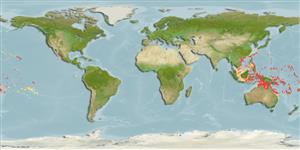Environment: milieu / climate zone / depth range / distribution range
Ecologia
marinhas demersal; intervalo de profundidade 1 - 70 m (Ref. 86942). Tropical
Pacific Ocean: Philippines to French Polynesia north to Taiwan, south to Australia.
Tamanho / Peso / Idade
Maturity: Lm ? range ? - ? cm
Max length : 3.0 cm TL macho/indeterminado; (Ref. 90102)
Descrição suscinta
Chaves de identificação | Morfologia | Morfometria
Espinhos dorsais (total) : 6 - 7; Raios dorsais (total) : 9; Espinhos anais: 1; Raios anais : 7 - 9. Characterized by orange red to yellowish body color, sometimes red on anterior head; elongate and filamentous second dorsal spine; all pectoral rays unbranched; fifth pelvic ray branched, 50-60% length of fourth ray; longitudinal scale series 23-24; predorsal scales 5-7; cheek without scales; upper opercle with 2-3 cycloid scales; depth of body about 3.9-4.2 in SL (Ref. 90102).
Benthic in crevices of coral rock walls, reefs, and on sand/rubble bottoms (Ref. 58302).
Ciclo de vida ou comportamento de acasalamento
Maturities | Reprodução | Spawnings | Egg(s) | Fecundities | Larvas
Eschmeyer, W.N. (ed.), 2003. Catalog of fishes. Updated database version of March 2003. Catalog databases as made available to FishBase in March 2003. (Ref. 46206)
Status na Lista Vermelha da UICN (Ref. 130435)
Ameaça para os humanos
Harmless
Uso pelos humanos
Ferramentas
Relatórios especiais
Baixar XML
Fontes da internet
Estimates based on models
Preferred temperature (Ref.
123201): 25.2 - 28.9, mean 27.6 °C (based on 362 cells).
Índice de diversidade filogenética (Ref.
82804): PD
50 = 0.5000 [Uniqueness, from 0.5 = low to 2.0 = high].
Bayesian length-weight: a=0.00708 (0.00333 - 0.01504), b=3.09 (2.92 - 3.26), in cm total length, based on LWR estimates for this (Sub)family-body shape (Ref.
93245).
Resiliência (Ref.
120179): Elevada, tempo mínimo de duplicação da população menor que 15 meses (Preliminary K or Fecundity.).
Fishing Vulnerability (Ref.
59153): Low vulnerability (10 of 100).
